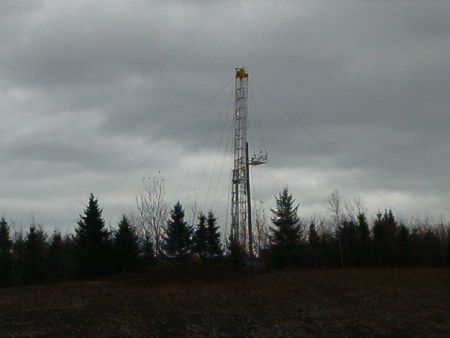By now most Nova Scotians are aware that there is a moratorium on hydraulic fracturing in Nova Scotia. The current government has assured us it will remain in place at least until after the reporting of the Wheeler Review in mid-2014.
The Wheeler Review is itself a response by the previous NDP government to the outcry about fracking, and to the clear lack of confidence in the government's in house review. One way that lack of confidence manifests has been the unwillingness of anyone to take the fracking wastes held in 'temporary' storage ponds since the fracking nearly six years ago.
The Department of Environment has repeatedly assured everyone about the safety of the processing of fracking waste waters that have been in Kennetcook, and now Debert. But those assurances have been rejected by Colchester County and the Town of Windsor, who have refused to have the wastes discharged into their sewage treatment plants.
Coal bed methane extraction is a technology closely associated with shale bed fracking. While there have long been leases in Nova Scotia for exploration, the very first that was heard about actual plans was in a news release from the new provincial government early in November.
Natural gas exploration in Pictou County is getting underway, under strict regulations from the departments of Energy and Environment.
“East Coast Energy has all of the necessary permits in place to begin exploring for local and cleaner sources of natural gas,” said Energy Minister Andrew Younger.
The permits do not allow the use of hydraulic fracturing.
East Coast Ventures went to even greater lengths to distance their project from fracking.
“It's not fracking.” But coal bed methane extraction produces waste water in similar volumes, and with the same potential for “naturally occuring” toxins- the same toxins whose presence in the Kennetcook fracking wastes has produced the impasse that has stranded them in 'temporary' waste ponds.
“Not fracking.” But one of the major reasons the former NDP government took its internal review of hydraulic fracturing out of the hands of the Departments of Energy and Environment, was precisely because of that broad vote of no confidence in Environment's assurances of the safety of the fracking waste processing they had approved.
“Not fracking.” But the Environment Department approvals for the Pictou County coal bed methane extraction use the regulatory protocols it has developed for hydraulic fracturing waste water.
“Not fracking.” But the early indications are that leakage from producing wells is even more prevalent with coal bed methane extraction than it is for shale gas fracking. Routine leakages contribute substantially to global climate change, and to local airborne pollution of volatile organic chemicals. Bland assurances from industry and government about the steel and concrete casings “sealing off” well bores have to be stacked up against data for the incidence of well casing failures.
“Its not fracking,” says our new Liberal government. But the much shallower depths of coal bed methane extraction poses even more risk of pollution of groundwater aquifers than does shale gas fracking.
“Not fracking.” But the intensity of the industrial infrastructure for coal bed methane extraction is the same as it is for shale gas fracking: wells counted in the hundreds, on pads a kilometre apart; and all the tanks, pipelines, access roads and compressor stations.
“Not fracking.” But Environment's own study describes in detail the same concerns with coal bed methane extraction waste water as there are with shale gas fracking.
“Not fracking.” But the industry, it's enthusiastic promoters in the Energy Department, and the enablers in the Environment Department have learned their lessons from the public outcry over fracking in Nova Scotia, New Brunswick and Newfoundland. They have kept the extended planning and approval of this coal bed methane project completely under wraps until the drill site was fully constructed and only lacked the imminent arrival of the drill rig.
“Not fracking.” Fingers crossed: no fracking in these first wells at least. Small matter that in a producing coal bed methane field, some of the wells have to be hydraulically fractured. So why was consideration of this project by government not tabled, pending the outcome of the province's review of hydraulic fracturing?



